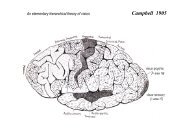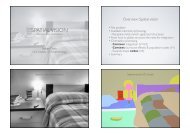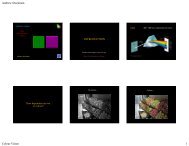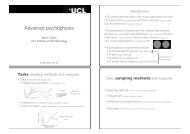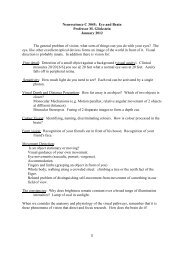Slow and fast pathways in the human rod visual system - CVRL main
Slow and fast pathways in the human rod visual system - CVRL main
Slow and fast pathways in the human rod visual system - CVRL main
You also want an ePaper? Increase the reach of your titles
YUMPU automatically turns print PDFs into web optimized ePapers that Google loves.
1658 J. Opt. Soc. Am. A/Vol. 8, No. 10/October 1991INit I(t 't 1 (1: S.O\V ROD PATHWAYIIALF- CYCLE DELAYOtTU'UT OF FAST ROD PATHWAYCOMBINEDOUTPUTSFig. 1. Self-cancellation of 15-Hz <strong>rod</strong> flicker. The flicker signalp<strong>rod</strong>uced by a s<strong>in</strong>gle stimulus (INPUT) travels through ei<strong>the</strong>ra slow or a <strong>fast</strong> pathway. At 15 Hz <strong>the</strong> signal emerg<strong>in</strong>g from <strong>the</strong>slow pathway is delayed by half a cycle relative to <strong>the</strong> signalemerg<strong>in</strong>g from <strong>the</strong> <strong>fast</strong> pathway. If <strong>the</strong> outputs from <strong>the</strong> two<strong>pathways</strong> are of equal amplitude, <strong>the</strong>y will cancel each o<strong>the</strong>r <strong>and</strong>p<strong>rod</strong>uce a steady, nonflicker<strong>in</strong>g signal when recomb<strong>in</strong>ed. Thus<strong>the</strong> light will appear nulled to later stages of <strong>the</strong> <strong>visual</strong> <strong>system</strong>.To expla<strong>in</strong> <strong>the</strong> restricted range of lum<strong>in</strong>ances with<strong>in</strong> which <strong>the</strong>null is found (see Figs. 2 <strong>and</strong> 3), we assume that <strong>the</strong> lum<strong>in</strong>ancedependencies of <strong>the</strong> slow <strong>and</strong> <strong>fast</strong> signals differ, such that <strong>the</strong>former predom<strong>in</strong>ates at lum<strong>in</strong>ances below <strong>the</strong> null <strong>and</strong> <strong>the</strong> latterat lum<strong>in</strong>ances above <strong>the</strong> null, <strong>the</strong> two be<strong>in</strong>g approximately equalat lum<strong>in</strong>ances with<strong>in</strong> <strong>the</strong> null. (The higher s<strong>in</strong>usoidal harmonicsof 15-Hz square-wave flicker have frequencies higher than <strong>the</strong><strong>rod</strong> <strong>visual</strong> <strong>system</strong> can follow 8 <strong>and</strong> are not shown here.)electroret<strong>in</strong>ographic results show a phase difference ofhalf a cycle (i.e., 1800) between <strong>the</strong> 15-Hz <strong>rod</strong> signals atret<strong>in</strong>al illum<strong>in</strong>ances just below <strong>and</strong> just above <strong>the</strong> null region<strong>and</strong> thus a rapid reversal <strong>in</strong> phase as <strong>the</strong> null regionis traversed.2. METHODSA. SubjectsA normal trichromat (author LTS) <strong>and</strong> an achromat(author KN) served as <strong>the</strong> ma<strong>in</strong> observers <strong>in</strong> this study.The normal observer is slightly myopic (-2 D) withnormal color vision as <strong>in</strong>dicated by conventional acuity<strong>and</strong> color-vision tests. Dur<strong>in</strong>g <strong>the</strong> experiment he wore nocorrective spectacles. The achromat observer displays all<strong>the</strong> classic symptoms of typical, complete achromatopsia(see Ref. 11 for a full description). No evidence has beenfound for cone function <strong>in</strong> his dark adaptation, fundal reflectometry,spectral sensitivity, threshold, spatial <strong>and</strong>temporal sensitivity, <strong>and</strong> directional sensitivity to light(for a summary, see Ref. 12). He is hyperopic <strong>and</strong> dur<strong>in</strong>g<strong>the</strong> experiments wore a +9.0-D convex lens. This lensmagnified <strong>the</strong> ret<strong>in</strong>al image so that <strong>the</strong> effective <strong>visual</strong>angles for him were 1.22x larger than those stated <strong>in</strong>Subsection 2.B.1.B. Apparatus <strong>and</strong> Stimuli1. Psychophysical MeasurementsIn our psychophysical experiments we used a threechannelMaxwellian view, optical <strong>system</strong> (see also Refs. 13<strong>and</strong> 14) to p<strong>rod</strong>uce <strong>the</strong> flicker<strong>in</strong>g test stimuli <strong>and</strong> steadybackground <strong>and</strong> bleach<strong>in</strong>g fields. All three channels orig<strong>in</strong>atedfrom a 100-W tungsten-iod<strong>in</strong>e lamp run at constantcurrent. One channel provided <strong>the</strong> flicker<strong>in</strong>g, 6-diametertest light. Its wavelength was shaped by a grat<strong>in</strong>g monochromator(Job<strong>in</strong>-Yvon V-10) <strong>in</strong>to a triangular profilepeak<strong>in</strong>g at 500 nm <strong>and</strong> hav<strong>in</strong>g a half-b<strong>and</strong>width of 4 nm.A second channel provided <strong>the</strong> 16'-diameter adapt<strong>in</strong>gStockman et al.field. It was rendered monochromatic by an <strong>in</strong>terferencefilter (Schott, Ma<strong>in</strong>z) hav<strong>in</strong>g peak transmittance at640 nm <strong>and</strong> a half-b<strong>and</strong>width of 5.5 nm. The lum<strong>in</strong>ances<strong>in</strong> <strong>the</strong> three channels were attenuated by neutral-densityfilters <strong>and</strong> wedges; <strong>the</strong> latter were controlled by stepp<strong>in</strong>gmotors (Berger, Lahr). The quantal-flux densities of <strong>the</strong>light beams were measured at <strong>the</strong> plane of <strong>the</strong> observer'spupil with a calibrated radiometer-photometer (UnitedDetector Technology, Model 80X Opto-meter).Fixation was 140 temporal <strong>and</strong> was aided by a small redfixation cross. To ma<strong>in</strong>ta<strong>in</strong> <strong>rod</strong> detection over an extendedrange of background <strong>in</strong>tensities for <strong>the</strong> normal observer,we used a 500-nm test field <strong>and</strong> a 640-nmbackground field (see Refs. 1 <strong>and</strong> 15). The 500-nm testfield was flickered at 100% contrast with <strong>the</strong> use of a frequencygenerator (Wavetek) connected to an electromagneticshutter. Flicker was square wave. The shutter hadrise <strong>and</strong> fall times of less than 0.1 ms.2. Electroret<strong>in</strong>ogram MeasurementsThe test flashes for <strong>the</strong> scotopic ERG measurements weregenerated by a commercially p<strong>rod</strong>uced Ganzfeld stimulator(Nicolet). Stimulus <strong>and</strong> record<strong>in</strong>g conditions were allexactly <strong>in</strong> accordance with <strong>the</strong> International Society forCl<strong>in</strong>ical Electrophysiology of Vision's ERG st<strong>and</strong>ard. 6The subject, positioned with <strong>the</strong> aid of a headrest, stared<strong>in</strong>to <strong>the</strong> center of a Ganzfeld bowl. The bowl was homogeneouslyillum<strong>in</strong>ated by white flashes p<strong>rod</strong>uced by a xenondischarge lamp (correlated color temperature 6000 K).Each flash was triggered by a computer (Nicolet CompactFour), which was also used for <strong>the</strong> ERG record<strong>in</strong>gs. Theduration of <strong>the</strong> flashes were 100 ns. For flicker p<strong>rod</strong>ucedat a given frequency, <strong>the</strong> flash was repeated <strong>the</strong> requirednumber of times per second. The flicker p<strong>rod</strong>uced by thisdevice was full field at 100% contrast. The flash lum<strong>in</strong>ancecould be controlled over a limited range by <strong>the</strong> computer<strong>and</strong> also by <strong>the</strong> <strong>in</strong>sertion of neutral-density filters(Kodak, Wratten) <strong>in</strong>to a filter holder. Special care had tobe taken to block all <strong>the</strong> stray light that leaked <strong>in</strong>to <strong>the</strong>apparatus from both external <strong>and</strong> <strong>in</strong>ternal sources.The mean lum<strong>in</strong>ances were measured by a Gossen photometerwith CIE VA characteristics, converted to photopictrol<strong>and</strong>s (phot. Td) <strong>and</strong> <strong>the</strong>n to scotopic trol<strong>and</strong>s (scot. Td)accord<strong>in</strong>g to <strong>the</strong> formulas given by Wyszecki <strong>and</strong> Stiles.' 7Lum<strong>in</strong>ances were also checked by monitor<strong>in</strong>g <strong>the</strong> amplitudeof output of <strong>the</strong> xenon discharge lamp by a siliconphotodiode <strong>and</strong> an oscilloscope.C. ProcedureBefore beg<strong>in</strong>n<strong>in</strong>g an experiment, <strong>the</strong> subjects dark adaptedfor between 30 <strong>and</strong> 45 m<strong>in</strong>, depend<strong>in</strong>g on <strong>the</strong> adaptationlevel to be used.1. Psychophysical MeasurementsFor <strong>the</strong> normal observer (subject LTS), <strong>rod</strong> isolation fordetection of <strong>the</strong> 500-nm test light was fur<strong>the</strong>r improvedby offsett<strong>in</strong>g <strong>the</strong> light's entry po<strong>in</strong>t 3 mm nasally from <strong>the</strong>pupillary center (s<strong>in</strong>ce oblique entry light is much lesseffective for cones than for <strong>rod</strong>s' 8 9 ). (This was not necessaryfor <strong>the</strong> achromat observer KN.) To effect this, wedilated <strong>the</strong> pupil by <strong>the</strong> application of a solution of 0.5%tropicamide (Mydriaticum, Roche) 30 m<strong>in</strong> before <strong>the</strong> startof <strong>the</strong> experiment.




